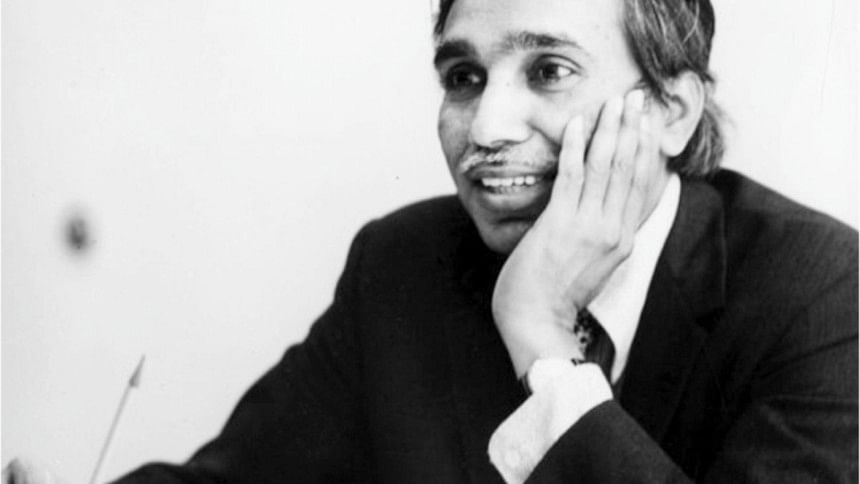F R Khan - A Bangalee legend from the golden chapter of our history

In the limited scope of this piece, I intend to remember the role of a great Bangalee in our Liberation War of 1971 - the Bangalee who, through his contributions, became a legend in the engineering world. There is hardly a Bangalee who is not familiar with his name. He was Dr. Fazlur Rahman Khan, better known as F R Khan.
F R Khan was a resident of Chicago, and a senior partner and chief architect of Skidmore, Owings and Merrill, the world-renowned architecture and engineering firm. He was declared 'Architect of the Year' six times, including in 1971. Later, through the use of a special structural system of design, he designed the Sears Tower, the tallest building of the world at that time, situated in Chicago, which brought him global fame and recognition.
A few years ago, US President Barack Obama noted in a speech directed to the Muslim world, and delivered in Cairo, "An American Muslim built our country's tallest tower". In that speech, the man he was referring to was none other than our legend, the pride of every Bangalee - Dr. F R Khan.
On March 26, after the military crackdown began, Dr. F R Khan provided leadership to mobilise Bangalees scattered around the United States. With the help of some prominent Americans, he set up the Emergency Welfare Appeals fund. He also founded the Bangladesh Defense League. Despite his busy schedule, Dr. Khan served as the chairman of both these organisations.
At that time, there were many high ranking Bangalee officers in the Pakistani embassy in Washington, and the UN permanent mission in New York. Among them was the Vice Consul of the UN mission, Mr. A H Mahmud Ali (current foreign minister of Bangladesh), who dissociated from Pakistani Mission on April 26. In fact, he was the first serving Bangalee diplomat from any Pakistani mission outside India to pledge his allegiance publicly to Bangladesh. Among others were S A Karim and Enayet Karim (second and third foreign secretaries of Bangladesh, respectively), S M Kibria (former finance minister) and A M Muhith (current finance minister). Among them, Mr. Muhith left the embassy on June 30 and remained in touch with the movement in the United States. On July 5, the Mujibnagar government issued a directive to the embassy officials to quit the embassy and set up the Bangladesh missions in Washington and New York. Although other officers were willing to transfer allegiance, promise of financial assistance from the provisional government was not enough for their sustenance. At this stage, Dr. F R Khan met with the officers, and promised them additional financial support until victory was attained in the Liberation War, leading to en-masse defection of all Bangalee diplomats and staff in Pakistani missions in both Washington and New York. At that time and situation, it is not difficult to extrapolate the depth of his love for the people of his motherland which motivated him to make such a promise.
After our victory in the Liberation War, Dr. Khan visited Bangladesh at the special invitation of Bangabandhu Sheikh Mujibur Rahman. In 1999, during the first government under the leadership of Sheikh Hasina, he was posthumously awarded the Shadhinata Padak.
In the early 70s, when I was studying at the University of Illinois at Urbana-Champaign to pursue my doctoral study, I met this great Bangalee. Like me, he too came from Faridpur and as such, was a little partial in his affection for me. Incidentally, after Dr. FR Khan, I became the second Bangladeshi to receive a doctorate in Engineering from the said university's prestigious engineering school. Because of our common last name, professors at my school would often ask if we were relatives. At that time, he used to teach a course titled Tall Building Design, some eighty miles away in Springfield, a satellite campus of the university. An Indian roommate of mine from the Department of Civil Engineering was enrolled in the course, and although I was not a student of Civil Engineering, I used to accompany him to attend Dr. Khan's lectures.
After designing the Sears Tower – a building that Newsweek termed as the "best engineering invention of 1973 – Dr. Khan designed a number of famous buildings, including the John Hancock Tower and the Jeddah Hajj Terminal.
People would also be amazed to know that he superseded 17 university alumni Nobel Laureates to be recognised as the Notable Alumni of the University of Illinois. In addition, he is known as the Albert Einstein of structural engineering and the best structural engineer of the 20th century. I am not aware of any other Bangladeshi who has been bestowed with such an honour.
It was a great loss to the world – the field of structural engineering, in particular - when on March 27, 1983, at the age of only 53, the legend bid us adieu forever. The news of his death shook everyone, as exemplified by the reaction of another war legend Justice Abu Sayeed Chowdhury, who said, "After reaching the highest spectrum of pursuit, he was a humble man, whose patriotism fascinated me. He spent all his life away from the country; how could anyone know the depth of his love for the people of his motherland; how could they perceive the cruel pain of anguish that was troubling him. He left us today, did not wait for Thanksgiving and did not allow us to say goodbye. The tears in my eyes are flowing as I started to write about him. Unblemished memories of him will always shake me as it is doing now, as long as I live. "
The writer is the Convenor of the Canadian Committee for Human Rights and Democracy in Bangladesh.

 For all latest news, follow The Daily Star's Google News channel.
For all latest news, follow The Daily Star's Google News channel. 



Comments